MENU
MENU
Tea production area: Hamamatsu City, Kakegawa City, Iwata City, Fukuroi City, Mori Town, Kikugawa City, Makinohara City, Omaezaki City and Shimada City
Brand name of tea: Hamamatsu tea, Haruno tea, Tenryu tea, Kakegawa tea, Higashiyama tea, Gomyo tea, Kikugawa tea, Fukuroi tea, Enshu-mori tea, Makinohara tea, Omaezaki tea, Shimada tea, Kanaya tea, etc.
Types of tea: Sencha (medium steamed green tea), fukamushicha (deep steamed green tea), kukicha (stem tea), matcha, tencha, hojicha (roasted green tea), genmaicha (popped rice green tea), gyokuro (high-quality shaded tea), kabusecha (shaded green tea), black tea, bancha, powdered tea, oolong eta, flavored tea, hakuyocha (white leaf green tea), etc.
Suitable climate for cultivating tea
Shizuoka Prefecture has a warm climate with many rivers, and fog is often generated. Many parts of Shizuoka Prefecture are suitable for tea cultivation.
Mainly fukamushicha is produced in the western part of Japan and on the Makinohara Plateau. Sencha is produced in the upstream area of the Tenryu River in the mountains of Hamamatsu City.
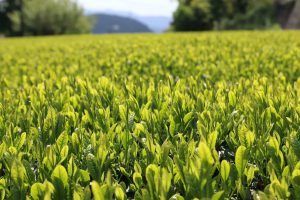
Haruno Town, Tenryu-ku, Hamamatsu City (April 2021)
Meiji Restoration and tea cultivation on Makinohara Plateau
A large-scale tea field extends over the Makinohara Plateau. The land reclamation and tea cultivation on Makinohara Plateau began as relief measures for the former shogunate retainers who lost their jobs due to the Meiji Restoration. In 1869, about 300 former shogunate retainers and their families settled there. Until their houses were built, they stayed at local people’s houses. More former retainers and their families settled continuously.
In 1871, due to the prohibition of Kawagoeninsoku (川越人足 were laborers who carried a person or a load on their shoulders across the river), the laborers lost their jobs. About 100 laborers also settled on the Makinohara Plateau and started to cultivate tea fields. When the local farmers saw that the former retainers and the laborers were cultivating tea fields, they also began to cultivate tea. Consequently, tea fields increased. However, many former retainers left the settlements because they were not accustomed to hard farm work.
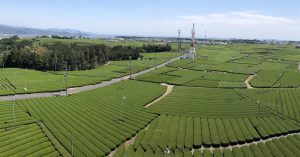
Tea fields on the Makinohara Plateau (May 2019)
The beginning of Fukamushicha (deep steamed green tea)
There are many theories as to the origin of fukamushicha. It is said that the manufacturing process of fukamushicha was established in Kikugawa City on the Makinohara Plateau between around 1955 and 1965. After that, the method spread out to other tea production areas.
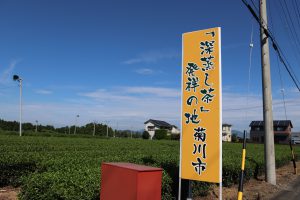
A sign with “the birthplace of fukamushicha” in Kikugawa City (September 2019)
Tea leaves cultivated on the Makinohara Plateau are thick, and the sencha taste of the tea leaves have a strong bitterness and astringency due to the long daylight hours.
Normally, the time for steaming tea leaves for sencha is about 30 to 50 seconds, but for tea leaves from that area, steaming time is lengthened to about 60 to 120 seconds in order to reduce the bitterness and astringency. The tea leaves of fukamushicha break more finely, and the color of brewed fukamushicha is dark green.
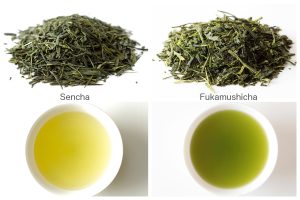
Sencha and fukamushicha
Shizuoka’s Chagusaba farming method (traditional Tea-grass Integrated System in Shizuoka)
A traditional tea farming method “CHAGUSABA” has been conducted primarily in Shizuoka Prefecture for many years. The method is a circular agriculture, creating harmony between human beings and nature.
“Cha (茶)” means tea, “gusa (kusa) (草)” means grass and “ba (場)” means place in Japanese. The grasses are called Chagusa (茶草) and the grasses habitats are called Chagusaba (茶草場). Chagusa is semi-natural grassland.
Grasses such as pampas, bamboo grasses, etc. around tea fields are cut and put in furrows between tea plants as mulch. These grasses become compost in the tea fields. In addition, the laying of grasses makes it difficult for weeds to grow and prevents the soil from being displaced by rainwater.
Using Chagusaba, the grasses around tea fields are mowed so that small flora and fauna can continue to live by receiving ample sunlight. This farming method maintains the environment and biodiversity.
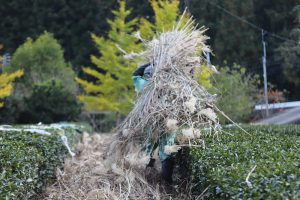
A tea farmer who carried Chabusa in Kakegawa City (November 2020)
Shizuoka’s CHAGUSABA farming method conducted in these four cities (Kakegawa, Kikugawa, Makinohara and Shimada) and one town (Kawanehon) in Shizuoka Prefecture was certified as a Globally Important Agricultural Heritage System (GIAHS) by the Food and Agriculture Organization of the United Nations (FAO) in 2013. However, CHAGUSABA farming method has been conducted in some places other than these five locations in Shizuoka Prefecture and in some other prefectures of Japan as well.
Many tea related facilities and events
You can enjoy tea tourism in this area. There are many tea cafes and attractive places involving tea to visit.
– Tea museum, Shizuoka in Shimada City
– Fukuroi City tea culture museum in Fukuroi City
– Chamonji on Mt. Awagatake in Kakegawa City. Cha means tea, and monji means letter in Japanese. “茶“ (TEA) is formed with about 1,000 hinoki cypresses, and its longitudinal/lateral size is 130m each way on Mt. Awagatake.
– KADODE OOIGAWA in Shimada City.
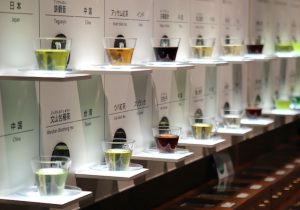
Tea museum, Shizuoka (November 2019)
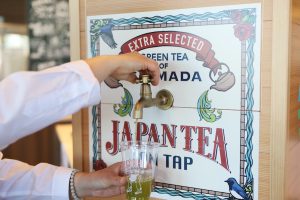
A green tea water tap in KADODE OOIGAWA (December 2020)
Kakegawa Shincha (new tea of the season) marathon
Kakegawa Shincha (new tea of the season) marathon has been held in April every year, though the marathon was not held between 2020 and 2022 due to the spreading of COVID-19.
In the new tea season, a tea picking or tea event is held in many places.

2019 Kakegawa Shincha maratthon
Related article on the site:
Tea mascot Yuru-Chara:
Chanomiya Kinjiro (Kakegawa City), Eicha kun (Shimada City), Oshima chan (Shimada City Society of Commerce and Industry), Kikunon (Kikugawa City) and Charfing (Makinohara City)
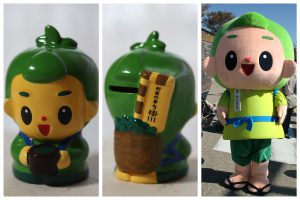
Chanomiya Kinjiro
Tea related event:
Tea related facilities:
Tea Museum, Shizuoka ふじのくに茶の都ミュージアム https://tea-museum.jp/index_en.html
Higashiyama Ippukudokoro 東山いっぷく処 http://www.higashiyamacha.jp/index.html
Kapposhi terrace(粟ヶ岳世界農業遺産茶草場テラス)
https://www.city.kakegawa.shizuoka.jp/kanko/spot-list/12456.html
Fukuroi City Tea culture museum 袋井市茶文化資料館 https://fukuroi-tyabunkashiryokan.jp
KADODE OOIGAWA 緑茶・農業・観光の体験型フードパーク
https://kadode-ooigawa.jp
Kakegawa Shincha marathon 掛川・新茶マラソン https://kakegawa-shincha.jp
Ceramic and pottery art: Shitoro ware and Moriyama ware
Reference:
松下智 (平成3年) 日本名茶紀行 (初版) 雄山閣出版
高野實・谷本陽蔵・富田勲・中川致之・岩浅潔・寺本益英・山田新市 (2005) 緑茶の事典 (改訂3版) 柴田書店
大森正司、阿南豊正、伊勢村護、加藤みゆき、滝口明子、中村羊一郎編(2017) 茶の事典 初版第一刷 朝倉書店
世界農業遺産静岡の茶草場農法 https://www.chagusaba.jp
大石貞男(昭和56年) –明治維新と茶業– 牧之原開拓史考(再版) 静岡県茶業会議所
丸尾記念館 牧之原開拓150周年記念企画展「丸尾文六による牧之原開拓の概要」
栗林沢一(昭和59年) 牧之原今昔 御前崎町郷土史研究会 ユートピア写植印刷
*When visiting the shops and facilities introduced in this article, please check the business hours on their website, etc. before visiting.
*The information provided on this site may be updated. If you find any information in this article that is incorrect, new, or incomplete, please contact CHAMART.
*The site does not describe all “Teas of Japan” or all “Teas of the World”. Additionally, each article expresses the writer’s personal experience and feelings.
#GIASH #Chagusaba